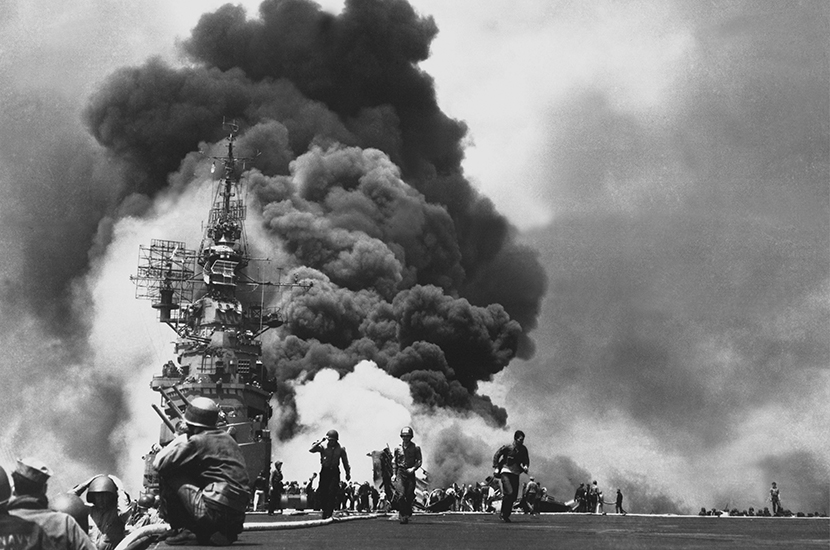The US operation of 1945 to take the island of Okinawa was the largest battle of the Pacific during the second world war. Seven US divisions were used in the operation, approximately half a million men, along with the entire US Pacific fleet of 1,457 ships. The initial assault was led by a landing force of 183,000, which brought with it 747,000 tons of cargo. It was, according to this superbly researched, well-written book, ‘the greatest air-land-sea battle in history’.
The US side was led by Lieutenant General Simon Bolivar Buckner Jr, the son of a famous Confederate general. His opponent on Okinawa was Lieutenant General Mitsuru Ushijima, whose force of 60,000 was vastly outnumbered — but the terrain was in his favour. Okinawa, a densely forested subtropical island of coral escarpments and valleys, was excellent for defence. In anticipation of the US attack, the Japanese had dug more than 60 miles of tunnels, where they would await the onslaught.
D-Day on Okinawa was 1 April 1945 and it began with a colossal artillery barrage from the US fleet. By nightfall, 60,000 US troops were ashore, but the Japanese were nowhere to be seen. The calm was short-lived. As the Americans advanced inland, the fighting quickly descended into a scene of almost hallucinatory horror. Neither side gave any quarter, and the Japanese were driven from their defensive positions by flamethrowers, napalm strikes and hand-to-hand combat.
As US troops advanced inland, the fighting descended into a scene of almost hallucinatory horror
The loss of life was horrendous. One US commander calculated that, once replacements had been taken into account, the casualty rate in his unit had been 185 per cent. A near unreadable passage describes an effort to recover the corpses of US Marines killed in the assault of Sugar Loaf Hill. One soldier recalls finding ‘bodies so decomposed they had started to turn green and were falling apart’. Another man ‘threw up after he tried to pull the body of a Marine and its arm came off at the shoulder. Eventually they put a head, torso, two arms, two legs in each poncho and left it to the Graves Registration to sort out the pieces later.’
An equally hideous war was underway in the seas around Okinawa, where the US fleet came under repeated attack from kamikaze pilots. These suicide tactics were terrifying and bewildering for US servicemen. They also proved brutally effective — the kamikaze assault of 6 April sank or badly damaged no fewer than 26 US ships.And yet one of the most moving moments of the book comes in an account of a kamikaze pilot saying goodbye to his new wife. ‘When will I see you again?’ she asks. ‘I’ll be back,’ he replies, ‘when it rains.’
It’s hard to know what to make of such a remark. Its poetic quality is striking, but perhaps also an indication of the extent of the pilot’s delusion, especially when it’s set alongside the horrific account of a Japanese nurse who worked in an underground dressing station on Okinawa. ‘Those with brain fever were no longer human beings,’ she wrote. ‘They’d tear off their clothes because of the pain. They were tied to the pillars, their hands behind their backs.’ Amputations were carried out with no anaesthetic, she recalled, and the dead were simply thrown out into the shell-holes, ‘with no time for sobbing or lamentation’. The nurse who wrote this was 16.
The extremity of the fighting had consequences that went far beyond the jungle. Roosevelt had approved the Okinawa campaign, but died before its completion. It was Truman who saw it through to eventual victory in June. But having taken Okinawa, the new president faced the sickening prospect of a full land invasion of Japan, one that his military advisers estimated would cost the lives of between 750,000 and one million men. Truman desperately wanted a way of ‘preventing an Okinawa from one end of Japan to the other’.
In this way, the nightmare of Okinawa shaped the logic of the atom bomb. As one White House adviser put it:
We had been through those bitter struggles of Iwo Jima and Okinawa. And while the bomb was a horrible thing, the number of lives lost by the dropping of those two bombs was a fraction of the number of lives that would have been lost had the war proceeded to go on to the mainland of Japan.
In the chow line on Okinawa, the news of the bombs and of the Japanese surrender was greeted with ‘scattered shouts’ among the men. But, as one private recalled, there was no sense of jubilation. Instead, he wrote: ‘The survivors of the abyss sat hollow-eyed and silent, trying to comprehend a world without war.’
And it really had been ‘the abyss’. The carnage of the 82-day Okinawa campaign almost defies belief. The majority of the 110,000 Japanese and Okinawan defenders were killed, as were 125,000 Okinawan civilians. US casualties numbered 76,000. Among the dead was Ushijima, who committed ritual suicide, and also General Buckner, killed at an observation post. His decision to wear a helmet bearing the three stars of his rank attracted the attention of Japanese spotters. Buckner was the most senior US officer killed during the second world war.
The idea of war is often invoked as a metaphor for struggle — politicians have even called for a ‘war’ on coronavirus. This book reminds us how glib that is, and that the defining characteristic of war is the mass destruction of individuals, both physically and psychologically. On returning to life in the US, one Okinawa veteran recalled:
You walk down the street looking much the same as everyone else, but you do not think or feel the same. You pray that you will be able to maintain a behaviour that will keep you out of trouble in a normal peaceful society. But you are, inside, much closer to the jungle than the city street.






Comments